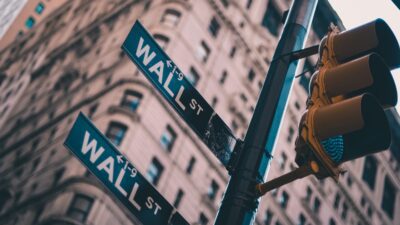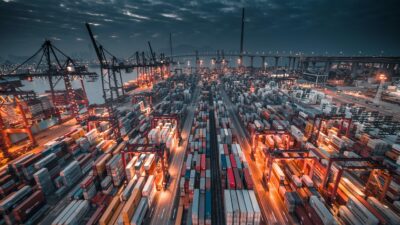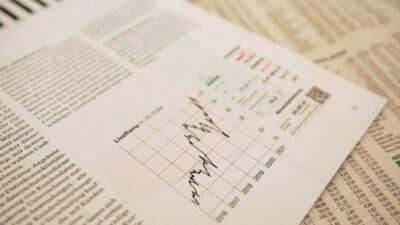Sandra Peter and Kai Riemer

Weathering the perfect storm of container shipping on The Future, This Week
This week: COVID, climate and containers: how the world weathers the global logistics crisis and a quick look at the Facebook files, ByteDance, finfluencers, Shell gets out of shale and AR spiders.
Sandra Peter (Sydney Business Insights) and Kai Riemer (Digital Futures Research Group) meet once a week to put their own spin on news that is impacting the future of business in The Future, This Week.
The stories this week
08:47 – The perfect storm for container shipping
Other stories we bring up
TikTokers watching financial disclosures of members of Congress for stock tips
Our previous discussion of finfluencers on The Future, This Week
ByteDance is getting ahead of China’s crackdown on tech for teens
The Facebook Files, WSJ’s investigative podcast series
Royal Dutch Shell sold its oil and gas production in the Permian Basin
AGL to set “short-, medium- and long-term” decarbonisation targets
Researchers at the University of Basel are using augmented reality to help reduce fear of spiders
Science opportunities during Covid-19 on Corona Business Insights
Record freight container production fails to ease supply-chain crisis
Shipping container stats and insights
More shipping and container stats including the capacity of container ships in seaborne trade, global shipping prices, and the average price of a shipping container
Lorry driver shortages and the shipping crisis
How the crisis in the shipping industry is choking the economy
Follow the show on Apple Podcasts, Spotify, Overcast, Google Podcasts, Pocket Casts or wherever you get your podcasts. You can follow Sydney Business Insights on Flipboard, LinkedIn, Twitter and WeChat to keep updated with our latest insights.
Send us your news ideas to sbi@sydney.edu.au.
Music by Cinephonix.
Dr Sandra Peter is the Director of Sydney Executive Plus and Associate Professor at the University of Sydney Business School. Her research and practice focuses on engaging with the future in productive ways, and the impact of emerging technologies on business and society.
Kai Riemer is Professor of Information Technology and Organisation, and Director of Sydney Executive Plus at the University of Sydney Business School. Kai's research interest is in Disruptive Technologies, Enterprise Social Media, Virtual Work, Collaborative Technologies and the Philosophy of Technology.
Share
We believe in open and honest access to knowledge. We use a Creative Commons Attribution NoDerivatives licence for our articles and podcasts, so you can republish them for free, online or in print.
Transcript
Disclaimer We'd like to advise that the following program may contain real news, occasional philosophy and ideas that may offend some listeners.
Kai So, what are we talking about?
Sandra Well, we could do an update on last week's episode on finfluencer and financial advice on TikTok, because it does seem that TikTokkers are trading stocks by looking at what Congress members do in the US. There was something on NPR last week talking about the fact that there seem to be a lot of young investors who have a new strategy and are now using TikTok to disseminate the financial disclosures that sitting members of Congress have to do in the US, and share stock tips. So they're looking at what for instance, how speaker Nancy Pelosi's trading activities are, in fact, those of her husband as members of Congress in the US have to disclose trades that themselves and their family members do, and then are copying those trades. And it seems that Nancy Pelosi in particular seems to be doing extremely well. She's called the queen of investing in TikTok. So people just follow and copy her trades.
Kai So we're not giving financial advice here on The Future This Week. And this is not day trading, right. So members of Congress have up to 45 days to disclose their trade. So these are people who actually doing investing for the long-term off of the kind of things that these people put in their portfolios. So maybe actually a prudent way of going about things. Yeah, so we could also talk about the Facebook files, which is making headlines. So the Wall Street Journal got their hands on internal reports and documents from Facebook. And they are running a five-part series as a podcast revealing different areas in which Facebook has done internal research or has become aware of problems with its platforms, and has not reacted to actually curb or weed out those problems.
Sandra And there's been quite a few, I mean, there's been revelations not only in the Wall Street Journal, but that's been picked up by pretty much every single news media outlet highlighting different aspects of these revelations. They've been insights into many different kinds of research that Facebook has done internally.
Kai Yeah, and many of those we've touched on or actually discussed on the podcast. So I'll just list them briefly here and we might come back to them. So one was that Facebook is actually running a separate content moderation practice for so-called VIP users, high-profile users. And the Wall Street Journal exposed how that leads to problems most prominently with things like you know, Donald Trump inciting violence. But that over time, a few million users actually ended up on this list, compromising the content moderation practices. Facebook has done internal research that shows that Instagram is harmful for the mental health of especially teenage girls and hasn't really done much about it. There's research that shows that the changes Facebook made to its algorithms in 2018, the so-called 'family and friends algorithm' when the algorithm started privileging how much engagement and post got actually lead to spreading of more controversial, more harmful content and people inside Facebook warned that this would happen. But Zuckerberg apparently he was more concerned that engagement is good for the platform, and for the bottom line. There is evidence that Facebook knew for a long time that its platform causes harm in developing nations. And also research around the anti-vaccine activists that are using Facebook to sow doubt. So no doubt this will be in the news for a while and maybe we are coming back to this in a future episode.
Sandra We could move to the other side of the world where there was an interesting move by ByteDance, the parent company of TikTok, that is getting a head of regulation in China in limiting the time that children under the age of 14 can spend on the Douyin platform, which is China's counterpart to TikTok. So they're limiting the time to 14 minutes a day. And this is seen pretty much as a proactive measure that is meant to reassure investors and also regulators, as we've seen in China, new regulations that limited children's online gaming to three hours a week.
Kai And specific times on the weekend. So this move by ByteDance can be seen as a form of pre-emptive compliance to potential regulation that the Chinese authorities might or might not bring in. And there's also been big news in the fossil fuel industry.
Sandra Yes, Royal Dutch Shell only a few days ago, sold its Permian Basin oil holding for almost $10 billion. And that is its oil and the gas production in the biggest American oil field sold to ConocoPhillips. And this is a sign again, that show much like other European oil companies has been under a lot of pressure to sell off oil and gas production and move towards clean energy, of course as a response to concerns around climate change, not only by the general public, but also by investors in these companies. And this is a very significant move since shell is retreating from what is the largest American oil reserve, which accounts for more than 40% of the total American oil output. And interestingly, just yesterday, here in Australia, AGL, one of our heaviest greenhouse gas emitters has had its shareholder meeting, where a comfortable majority, over 55% of the investors supported a motion for the energy company to set short, medium and long-term, decarbonisation targets that would be in line with the Paris agreement with the aspiration to keep global warming below two degrees.
Kai And this is a really interesting move, because it seems like the business community, especially here in Australia, is moving ahead of the government, which seems to be much more pro fossil fuel than many investors or banks are. So companies reacting to this and increasingly trying to move away from fossil fuels, even those companies who have this as their core business. So very interesting to keep an eye on.
Sandra But that still leaves the question of what should we talk about today. And as tempting as it was to talk about this new smartphone app where university researchers are using augmented reality to reduce people's fears of spiders. So augmented reality, so you can project a spider onto your skin or onto your hand and basically do exposure therapy without being exposed to actual spiders. And given that about 5% of the population is scared of spiders, they seems to be a good use of augmented reality technology.
Kai Especially for people in Australia, where spiders of all sizes, small and quite large, are basically part of daily life. This research published in the Journal of Anxiety Disorders might actually point to a good and low cost way to do something about this arachnophobia.
Sandra So as tempting as it was to pick one of these stories, think we're going back to the roots of The Future, This Week, where we had all these like super-exciting, engaging conversations around batteries, salaries, and taxes and fax machines. We're going back to one of those and today we're going to, I think, have to look at shipping containers.
Kai Yes, the exciting world of shipping containers.
Sandra There is a perfect storm brewing. So if there is a time to do this, the time is now.
Kai Let's do this.
Sandra Let's do this.
Intro From The University of Sydney Business School, this is Sydney Business Insights, an initiative that explores the future of business. And you're listening to The Future, This Week where Sandra Peter and Kai Riemer sit down every week to rethink and unlearn trends in technology and business. They discuss the news of the week, question the obvious and explore the weird and the wonderful.
Sandra So containers, all sorts of stories around shipping and around containers in all the big media outlets from The Economist to the Financial Times to the BBC, and then this morning, we're talking to our friend Jevin West...
Kai Who's in Seattle over in Washington State.
Sandra And he's looking out his window saying, 'What is it with all these...
Kai ...shipping containers. They're piling up, there's ships sitting idle out at sea waiting to be unloaded.'
Sandra So he also notes that there seems to be like the storm brewing around container shipping. And then we come across this story in The Economist.
Kai Aptly titled, "A perfect storm for container shipping".
Sandra So we thought, okay, now we have to do the story. So first, what is this perfect storm for container shipping we've been hearing all about. And it has to do with these record-breaking prices for containers, record-breaking shipping rates, it is now more expensive than ever to put something in a shipping container and load it onto a ship.
Kai So where the cost for shipping a container from Shanghai to New York, which is one of the most popular routes, would have been about $2,500 back in 2019, that is now almost tenfold, north of $20,000.
Sandra And it's not just that there's hundreds of vessels waiting outside of ports, much like outside Jevin's house in Seattle waiting to be offloaded. We keep hearing of incidents like the one in the Suez Canal where a ship got wedged and then 300 other ships could not enter the canal for a couple of days. We keep hearing of shutdowns across various ports, because of COVID.
Kai We keep hearing about companies not being able to secure shipping containers to get their shipments either out of China into the US or to Europe, or indeed the other way around.
Sandra And last but not least, there's even typhoons causing shutdowns across major ports in China. And this is a really, really big story. Because this is a really, really big industry. Today, about 90% of the world's goods are transported by sea.
Kai So 90% of all the stuff that goes into products, the products that we use, the products that we buy, have, at some point, been carried across the oceans by one of these big ships.
Sandra And about 60% of everything that gets carried around, including basically all of your like fruit and veg, and gadgets, and laptops, and phones, and cameras, all of these things are packaged and moved around the world in these really large steel containers.
Kai So containers are a big deal. They move the world and the industry has grown tremendously in the past 40 years. So in 1980, there was about 11 million, what's called 'deadweight tonnes' of container shipping capacity in the world. And that 11 million tonnes has grown to 275 million tonnes in 2020. So an enormous growth that has led to 10s of 1000s of these ships roaming the earth oceans carrying goods back and forth.
Sandra And when we say ships, we mean really big ships. So like the standard container today is 20 feet long, eight feet wide by nine feet tall, 20 foot equivalent container unit or TEU. large ships today are capable of holding around about 24,000 of these containers. That's like having a train that is 44 miles long, or as Megan whispers from the sidelines 70.8 kilometres long. And to put it as, and we'll include all the links in the shownotes, one of our colleagues in the conversation mentioned one of these ships could take 156 million pairs of shoes, or 300 million laptops or 900 million cans of baked beans. That's in case you haven't had lunch yet.
Kai That is a truly global industry with some really interesting international distribution. So for example, the largest ports in the world, and that is a reflection of where most goods are coming from are almost exclusively in China. Singapore ranks number two, but it's Shanghai on one, Ningbo, Shenzhen, Guangzhou, Qingdao. So there's a lot of humungous ports in China alone. But the industry as such is very much still dominated by European companies. For example, the largest cargo ship companies are from Denmark, registered in Switzerland, in France, there's one Chinese company. But do you know where most of these container ships actually registered, in which country?
Sandra I know 'cause you told me over coffee just before we did this podcast, but I'm gonna go 'no', for our audience.
Kai Number two is Singapore, number three is China, reflecting where those large ports are, but it's Greece, actually, a lot of the European ships sail under the Greek flag, a lot of the freight forwarders, the companies actually selling the shipping services, are Northern European, three of the top five are from Germany, which makes for an interesting mix of Old World Shipping and the geographic power shift towards Asia, where most of the stuff is now coming from.
Sandra So now that people have shared in our deep dive into the world of...
Kai Nerd out...
Sandra ...Container shipping. Let's have a look at where does this perfect storm really come from? And also, where is it going? Because the temptation is to say COVID, right, the answer now to everything is pretty much, COVID.
Kai And the answer to this one is actually COVID.
Sandra And also weather and Brexit, but we'll get to that. But COVID.
Kai So when the pandemic hit in the early days, the world expected very much a slowdown in global trade. And companies started to retire certain shipping routes and decrease the capacity in the system. And indeed, trade did slow for about two to three months.
Sandra And by slow we mean that in the early days of the pandemic, it basically ground to a halt. The decline in shipping was so, so significant, and we actually talked about this in one of our Corona Business Insights episodes that will put in the shownotes, that it was this once in a lifetime opportunity to study what happens when there are none of these ships, or very few of these ships on the international trading routes and scientists were studying what whales do in the absence of the noise from all of these ships. Well, that's a different story for a different podcast. So back to COVID. So COVID, in the first instance, grinds global trade and global shipping to a halt.
Kai But then what happens is as the pandemic goes on, governments around the world handout stimulus payments, and consumers revert to ecommerce, to online shopping. And because travel slows down, people divert money that they would ordinarily use for travelling, to consuming. And global trade, especially for consumer goods picks up and in the matter of months actually exceeds pre-COVID levels.
Sandra Yes, everything from PPE and webcams so we can work from home to...
Kai Toilet paper.
Sandra Toilet paper. But when this buying spree begins, Chinese exporters really struggle to get enough containers to ship these goods around the world. First, because the volume of trade really increases beyond what was normal. But also because many of these containers are stuck in various places around the world where they were whenever the pandemic started.
Kai So at this point, lots of containers pile up empty in the US and in other parts of the world, but not in China where they are immediately needed at that point.
Sandra And to add to that, processing these containers takes a lot longer around the world. Because of COVID some ports are closed altogether, because of outbreaks but also in the ports that are still there. Some workers are unable to work and the ones that are still working are working under COVID health restrictions.
Kai So the result is that by now the global shipping supply chains are clogged up. Around the world it is estimated that about 8 million of these TEUs, these container units, are stuck on ships waiting to be unloaded. 8 million units is pretty much what the two largest ports in Australia, Sydney and Melbourne unload every year. So a year's worth of Australian shipping capacity is sitting around the world on these ships.
Sandra And also outside our friend Jevin's window. And COVID adds another couple of complications to this. COVID also adds the on-and-off outbreaks in the second, third, fourth waves of the pandemic. As we've seen, for instance, in China, the Yantian International Container Terminal, normally one of the busiest ports in the world was shut down last month, again, adding to this pile up. We've seen reduced numbers of lorry drivers and people who assist that one or the other end of the shipping supply chain. We've seen additional problems with cargo processing, or just the fact that some of these containers are not available for the people who need them at the time they need them.
Kai So in the US, for example, a lot of manufacturers and agricultural producers who want to export their goods from inland mainland US cannot actually get their hands on shipping containers, because for companies it's actually more lucrative to ship an empty container straight back to China where it now earns a lot of money rather than using clocked up railroads to getting it to people in inland US to to export their goods.
Sandra It's not just COVID adding to where this crisis come from. There's COVID, there surprisingly also, you know, weather and climate change. Ever Given, one of the largest container ships in the world got stuck in the Suez Canal as it was traversing this very narrow 120 mile canal. There were fierce wind gusts that blew it into the bank and it basically just got stuck there with 200,000 tonnes of cargo. It then had to be dug up, and in the meantime hundreds of other ships piled behind it as Ever Given was stuck across the Suez Canal. And speaking of weather, also last week, three of China's busiest ports were shut down because of Typhoon Chanthu. So all up, a lot of things that have led to this kind of perfect storm that The Economist talks about.
Kai And so we could assume that this is just unusually high demand and a shortage of containers.
Sandra But that's not quite true. And we'll add a link in the shownotes to a Financial Times analysis that looks at the fact that it does seem to be more of a logistics issue than a supply issue, because there's now 20% more containers on these routes than before the crisis. And the global container industry is producing about 5 million TEUs, 20 foot equivalent units, this year. This is up two thirds on last year. So there is actually a tremendous amount of containers on the market. And we'll just mention here that about 80% of the world containers are done by only three big Chinese groups. But there is little to indicate that there's a shortage of container, it's just that they are not reaching the right destinations quickly enough to accommodate the demand.
Kai 8 million are sitting waiting to be unloaded. And they're also in the wrong places, basically.
Sandra So what to do? There is this perfect storm, but there are also solutions, and the best solutions would probably be systemic solutions. We always say, you know, technology is not the answer to everything. Technology likely could help in this instance, technology using global shipping actually hasn't been really forthcoming. And the industry has resisted implementation at scale. But it's one of the things that might help. Visibility of where the containers are, what the suppliers need, what shipping companies are doing and where, would allow better coordination across the supply chain, even with all the disruptions.
Kai What is really needed is a transparency at the systems level. Because what is happening is known in the literature as the 'whiplash' or the 'bullwhip' effect, there is a disruption in the supply chain, demand increases, but what happens is without visibility of what's going on participants in the market, because they are competing with each other, they overreact. So there's evidence now that companies are afraid that they can't fulfil their demand for Christmas, for example, so they start ordering more than they actually need. So because you're afraid that this one container from this one supplier might not arrive in time, just in case, you order another couple of containers of the same stuff from other suppliers. And when everyone does this, you get this huge compounding effect, excess orders that are not actually needed to satisfy demand, but which are done out of desperation, all adding to the same problem, further aggravating the clogging up of the supply chain, which then down the track leads to shipping companies container manufacturers, producing lots and lots of capacity to basically clear the backlog, which then in the mid-term can lead to an overcapacity in the system. Because once the backlog clears, and the problem subsides, and we go back to normal capacity, we now have so many excess shipping containers and ships in circulation that prices might actually drop. So how do you prevent this from happening? The answer is by introducing transparency and information at the systems level.
Sandra The supply chains could be made better by using data to provide visibility across the supply chain. However, there are few incentives built into the system to make that data available. Many of these shipping companies of the operators of the container producers actually benefit from the lack of visibility and the lack of data. For instance, for CIMC, the industry's largest producer of containers, last year meant its profits going up from about $37 million to $680 million, producing more and more shipping containers. And the same holds true for most players in that industry. Hence the system as a whole does not have an incentive to provide that access to data.
Kai So this is really the tragedy of these systems, right? Most players in the system would benefit from information sharing in the long-term, you know, getting the system back into equilibrium. But in the short-term, there is no incentive for information sharing as some of the companies are actually benefiting, like the shipping companies, and as other companies like retailers and wholesalers protect their data as competitive trade secrets. So a lack of individual incentives then not only leads to but actually aggravates the global problem that we're experiencing at the moment.
Sandra So that leaves companies themselves in the system, and some companies in the system have tried to stave off this perfect storm, including moves by companies such as CMA CGM, the third largest container shipping firm in the world, a French company, which basically shocked everyone a couple of weeks ago when it said that it would cap spot rates for ocean shipping in an attempt to stave off the crisis. And other companies followed suit.
Kai Which is actually a clever move, because you might forego some short term profit. But with a longer term view, a price cap will smooth out the system and leads to a stabilisation of those out-of-control order patterns much faster than it would otherwise do.
Sandra There's also a move towards decarbonisation in the industry that might in the long-term help rebalance the capacity in the system as older vessels get tired and basically reduced extra capacity that is being created now by the system overcorrecting.
Kai But there's also all the companies who are desperately waiting for their shipments reacting to what is going on. Large retail companies such as Home Depot and Walmart, reportedly have started chartering their own container ships so that they are less dependent on the market for moving their goods and services. And companies such as Peloton producing home trainers have tried to resort to air freight to move some of their products into the US because you know, a lot of their products are stuck in containers.
Sandra Another move for these companies could be to onshore or near-shore some of their production. And while some of that might be easier to do for a company that say manufacturers clothing or commodity goods, it becomes really a lot more difficult when we're thinking about relocating production for really complex products, phones, laptops, highly complex manufacturing.
Kai And it is worth mentioning that for most goods and services that are of higher value, the actual increase in cost for shipping is fairly marginal, because you can load a lot of iPhones or a lot of pants and clothes into a shipping container. The problem here really is the throughput and the fact that goods and services are held up and just don't make it to where they need to be on time. So where does this leave us? First of all, experts say that this current crisis will not subside in the very short-term, it will probably take a few months till the first half of next year for shipping prices to come back and the backlog to clear.
Sandra And while this disruption might prove worse, for some countries like the UK where Brexit has also left behind the shortage of lorry drivers, many of whom have gone back to the European Union or are now unable to work in the UK because of all the extra taxes and everything. But for some countries, this might provide an opportunity. We've mentioned countries like Vietnam, and Vietnam has just opened another deep sea port. And countries like Vietnam can use the opportunity provided by this crisis to establish themselves in the market.
Kai And so if you haven't done your Christmas shopping yet get in early because goods might actually be scarce this year.
Sandra That's all we have time for today. Thanks for listening.
Kai Thanks for listening.
Outro This was The Future, This Week, an initiative of The University of Sydney Business School. Sandra Peter is the Director of Sydney Business Insights and Kai Riemer is Professor of Information Technology and Organisation. Connect with us on LinkedIn, Twitter and Flipboard and subscribe, like or leave us a rating wherever you get your podcasts. If you have any weird and wonderful topics for us to discuss, send them to sbi@sydney.edu.au.
Sandra Yep, do you want to go again with the freight shipping?
Kai Freight shipping
Sandra It says fight shipping at the moment.
Kai Most of the freight shipping, fright shipping, fried shipping, frayed shipping,
Sandra Megan you can choose between fright shipping or fried shipping.
Kai Fright shipping, fried shipping or freight shipping. It's a frightening fright deep fried freight shipping.
Sandra Okay, so Ever Given, one of the largest shipping containers in the world got stuck in...
Kai No. Container ships, not shipping containers.
Sandra Ever Given, one of the. Ever Given one of the biggest ship container ahhh! Ever again.
Close transcript







